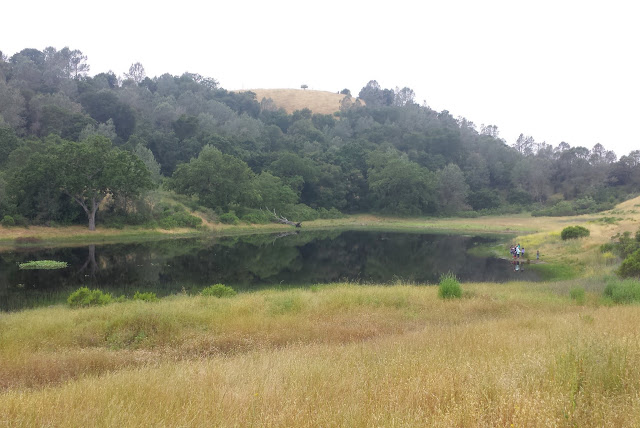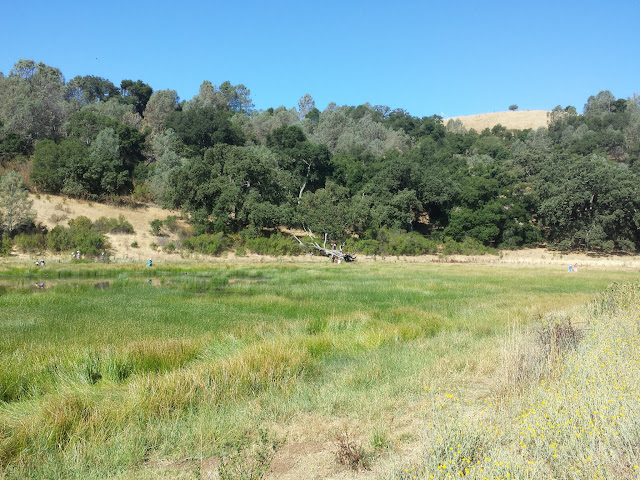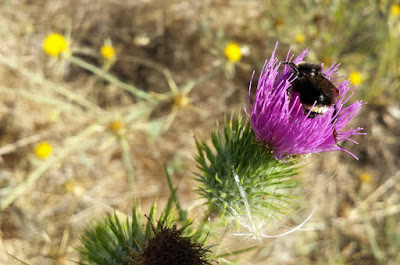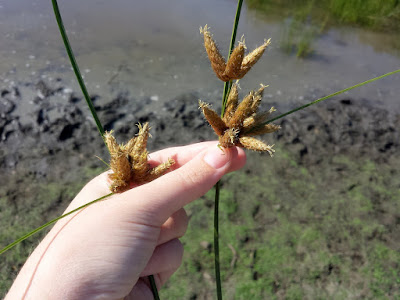To give you a visual: here's the pond in spring (top) and in summer (bottom)...
These were taken from almost the same spot. If you look closely, you can see the fallen tree on the far banks as a comparison. Pretty crazy, right? Here in California, that's about as much "change of seasons" that we get, so it's neat to be able to make observations at such a spot.
As you can see, the marsh grasses -- sedge, smartweed, cattails, and rushes -- take over almost all of the pond and leaving just a wet, mucky bit in the center:
In spring, the banks are covered in a beautiful, colorful range of wildflowers. But in summer, yellow star thistle and bull thistle run the show, with some tarweed and bindweed here and there. (There's a reason these varieties are considered invasive!) But the bees love them, even if we don't! ;)
We also found a new-to-us variety of sedge this week:
At least I think it's a sedge -- it looks so very different from the flatleaf variety we're used to. But I remembered "sedges have edges" from Botany in a Day and then did some Googling. ;) (If you know what kind it is, please give me details in the comments!)
Happy weekend!







Now that's pretty dramatic! What a neat place to get to watch the seasons change throughout the year. Does it fill back in gradually, or does a good storm or two turn it into a pond again quickly?
ReplyDeleteI think I've seen a sedge similar to that up here at our pond, come to think of it. We were watching dragonflies land on it over and over again a month or two ago. Never figured out what it was though!
I'm using Botany in a Day w/ Emma this year for her Biology selection - that and some reading about Linnaeus and Luther Burbank. I'm kind of winging it, but I think it will be good. :-D
It fills back in pretty quickly as soon as the rainy season (which is not all that rainy!) hits. But it stays like this or drier for at least a couple months and is fun to explore since we can walk all the way out to the center. We also find the most dragonfly casings, frog eggs, and other neat bits here. It has the most variety of life in anywhere we observe except the beach.
DeleteBotany in a Day is really fun. I always have grand designs of going through it methodically but get side-tracked. I definitely plan on using alongside my kids when they're old enough, though! I think that method of plant observation and identification is both useful and intuitive.
I think that's a vernal pool. Try taking a small amount of the soil when it's dry and add some dechloronated water to it and see what happens. I have a fun blog post here about what we found in ours: http://thechangingyearoc.blogspot.com/search/label/vernal%20pool
ReplyDeleteFascinating stuff!
Yes, it's a vernal pool! Besides the fact that it dries up in summer, it also doesn't have fish life as far as we can see, which lets the insect/microscopic/amphibian life flourish -- this is the spot we see newts, frogs, and toads as well as lots of water bugs, like here:
Deletehttp://joyouslessons.blogspot.com/2016/02/nature-study-month-of-weekly-winter.html
My friend has been doing microscope biology with her high schoolers using samples from this pond for the past year. I sent her a link to your page because she's going to really enjoy it -- thanks!
Great post.
ReplyDeletehttps://3dprintboard.com/member.php?49004-ShermanJacobs